MCB 2610: Eukaryotic Comparison and Antibacterials
1/121
There's no tags or description
Looks like no tags are added yet.
Name | Mastery | Learn | Test | Matching | Spaced |
|---|
No study sessions yet.
122 Terms
is the glycocalyx an internal or external structure in a eukaryotic cell?
external structures
what is the glycocalyx in a eukaryotic cell?
Sticky carbohydrates extending from animal plasma membrane
- Bonded to proteins and
lipids in membrane→ glycoproteins
- Strengthens the cell surface
- Helps attach cells together
- Cell-cell recognition
how do eukaryotic cells move
flagella and cilia: make it move or "beat"
- microtubules
what are pseudopodia or pseudopods
- contain cytoplasm
- used for cellular locomotion
do have bacterial flagella have a different structure than eukaryotic flagella
YES: completely different structure
what do flagella help with
propel the cell through water
flagella in eukaryotic cells are
few and long: whip-like
cilia in eukaryotic cells are
short and many: vibration-like
what are microtubules
long hollow tubes made up of a protein called tubulin
how many parallel pairs of microtubules surround the central pair of microtubules
nine parallel pairs: 9 (outside) + 2 (inside) array
what causes the flagellum to bend
sliding of the microtubules relative to each other
- up and down sliding
EXAM Q: bacteria is powered by proton motor force, but eukaryotic cells are powered by...
ATP!
what are features of the cell wall in eukaryotic cells
- simpler than bacterial
- consists of polysaccharides
- if they lack cell walls, they will have some kind of protective layer on them
what is the flexible outer protein covering protozoa
pellicle
what polysaccharides consist in plants
cellulose
what polysaccharides consist in fungus
chitin - N-acetylglucosamine (NAG) units
what polysaccharides consist in yeast
glucan and mannan
what are differences in the eukaryotic plasma membrane
eukaryotic: contains carbohydrates to attach on sites for bacteria
- contain sterols and increase resistance to osmotic lysis
- eukaryotic and prokaryotic are very similar: in function and basic structure
EXAM Q: what is the biggest difference between eukaryotic and bacterial plasma membranes
ENDOCYTOSIS
- Phagocytosis: pseudopods extend and engulf particles (eating)
- Pinocytosis: membrane folds inward, bringing in fluid and dissolved substances (smaller molecules, opposite of phagocytosis)
- Receptor-mediated endocytosis: binding to a receptor then membrane folds in (turning on receptor)
what is phagocytosis
pseudopods extend and engulf particles: eating
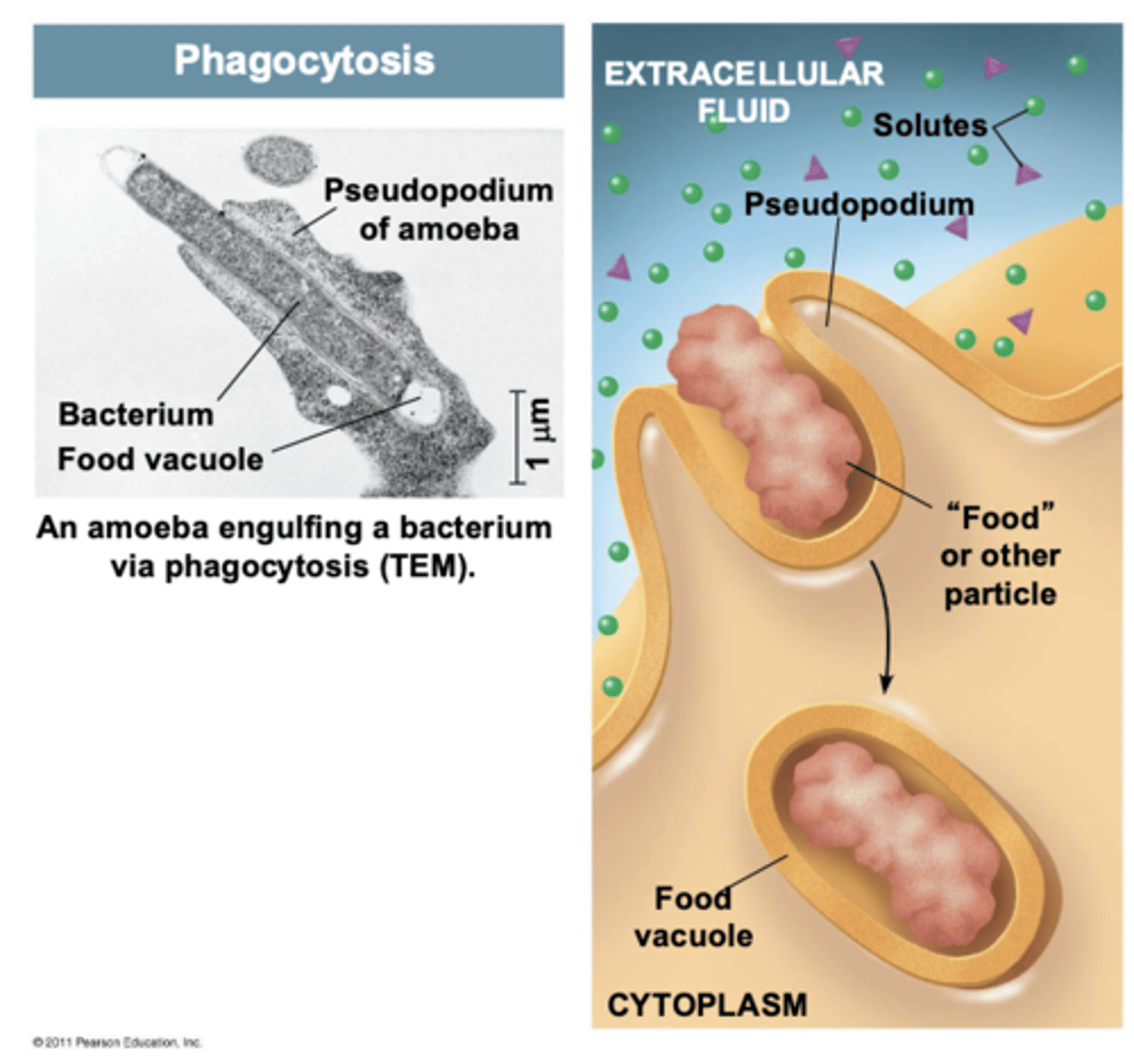
what is pinocytosis
membrane folds inward, bringing in fluid and dissolved substances: smaller molecules (opposite of phagocytosis)
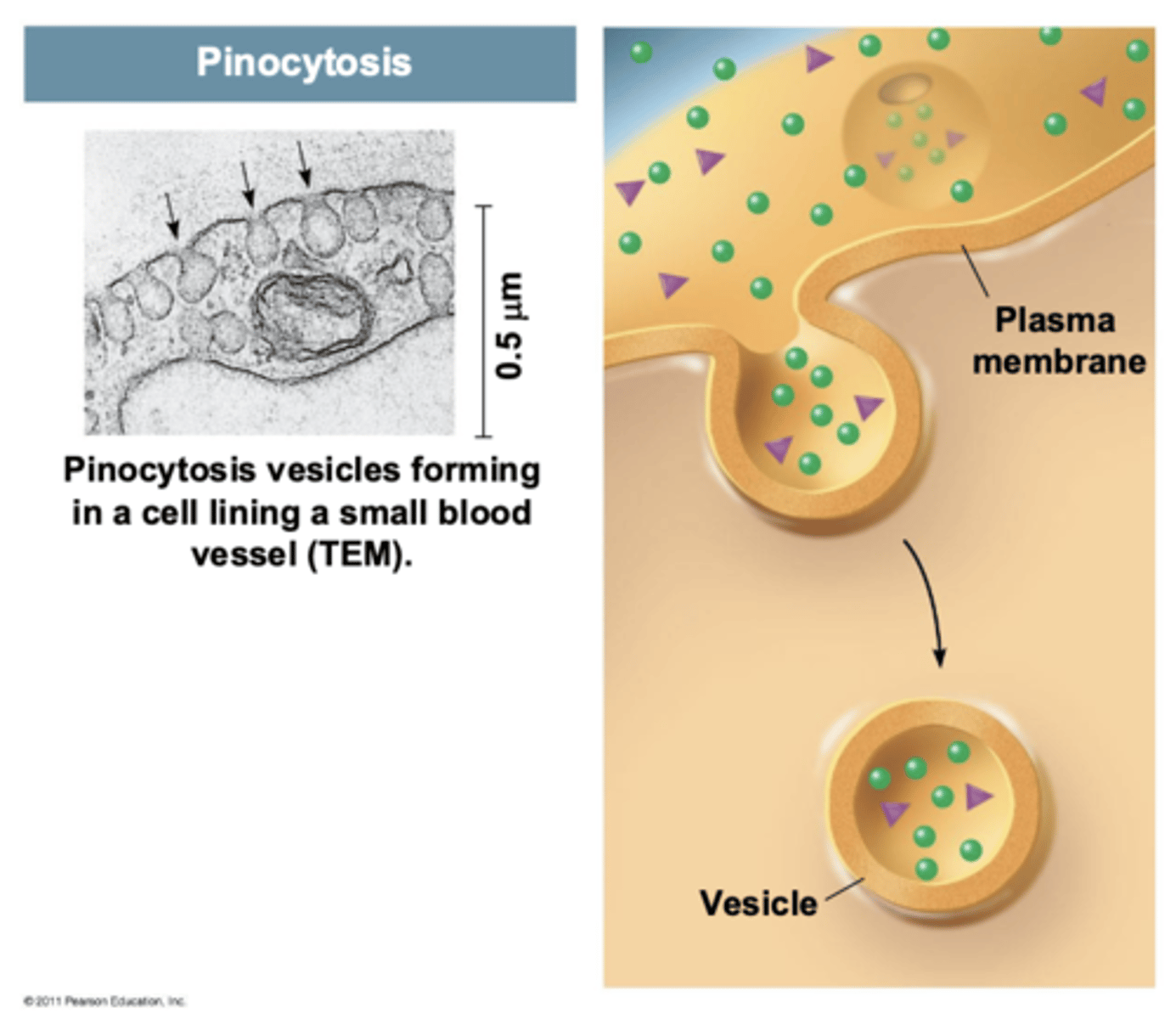
what is receptor-mediated endocytosis
binding to a receptor than membrane folds in: turning on receptor
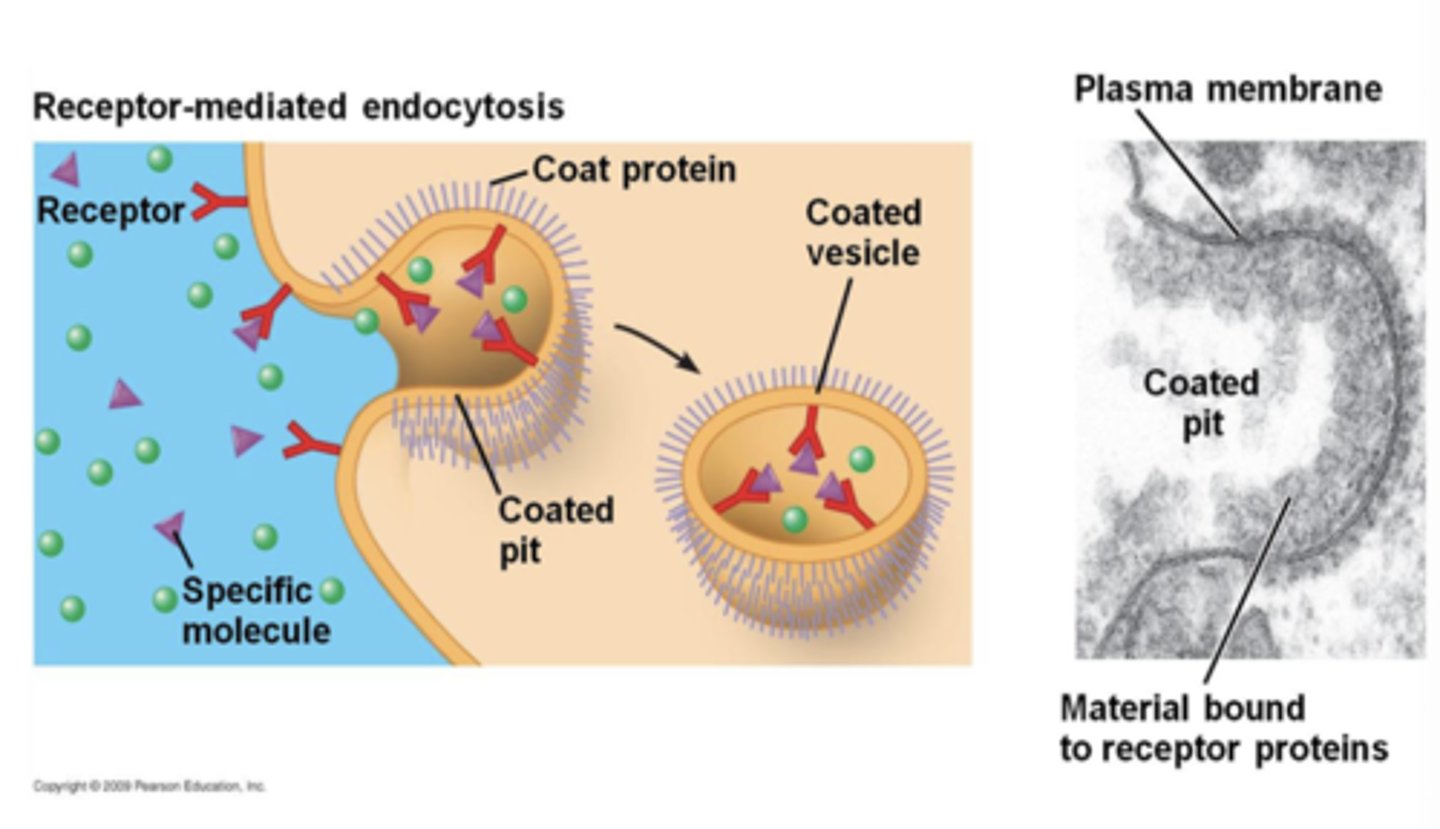
what is the major difference in eukaryotic cytoplasm compared to bacteria
Eukaryotic has complex internal structure, consisting of small rods
(microfilaments, intermediate filaments, microtubules) = cytoskeleton
where do most metabolic reactions occur
cytoplasm
what are cytoplasm traits
- a semifluid, gelatinous, nutrient matrix
- provides support, shape and assists in transport of substances
- contains storage granules and a variety of organelles: each organelle has a specific function and organelle means little organ
what are the subunits of ribosomes in eukaryotic cells
60S: large subunit
40S: small subunit
= 80S
what are the two locations for 80S
- Free ribosomes: suspended in the cytosol, makes proteins that function in the cytosol
- Bound ribosome: attached to the outside of the endoplasmic reticulum, make proteins for insertion into membranes
what are free ribosomes
suspended in the cytosol,
makes proteins that function in the cytosol
what are bound ribosomes
attached to the outside of
the endoplasmic reticulum, make proteins
for insertion into membranes
what is the role of the nucleus in eukaryotic cells?
contains chromosomes
what is the role of the ER in eukaryotic cells?
transport network
what is the role of the Golgi complex in eukaryotic cells?
membrane formation and
secretion
what is the role of the lysosome in eukaryotic cells?
digestive enzymes
what is the role of the vacuole in eukaryotic cells?
brings food into cells and
provides support
what is the role of the mitochondrion in eukaryotic cells?
cellular respiration
what is the role of the chloroplast in eukaryotic cells?
photosynthesis
what is the role of the peroxisome in eukaryotic cells?
oxidation of fatty acids;
destroys H2O2
what is the role of the centrosome in eukaryotic cells?
consists of protein fibers and centrioles, important for cell division
what is contained in the nucleus of eukaryotic cells
- DNA
- Nuclear envelope: encloses the nucleus, covered in pores
- Pore complex: regulates entry and exit of proteins and RNAs, as well as large complexes of macromolecules
what is inside the nucleus of eukaryotic cells
- DNA is organized into discrete units: chromosomes
- Structures that carry genetic information
– Each chromosome contains one long linear DNA molecule associated
with many proteins (histones)
– These proteins and the DNA together are called chromatin.
- The number and composition of chromosomes and the number of genes
on each chromosome are characteristic of the particular species of
organism. (Human diploid cells have 46 chromosomes (23 pairs), Elephants have 56 chromosomes, Nematodes have 11 chromosomes)
DNA is organized into discrete units called
chromosomes
what does each chromosome of eukaryotic cells contain
one long linear DNA molecule associated
with many proteins (histones)
proteins (histones) and DNA together make...
chromatin
what are lysosomes
digestive compartments:
- Is membranous sac with acid environment
- Have hydrolytic enzymes (work well in an acid environment)
- cells use to digest various molecules without harming the cytoplasmic
components of the cell.
- Can digest bacteria
what are organelles for energy in eukaryotic cells
mitochondria
characteristics of mitochondria in eukaryotic cells
- “Power plants,” “powerhouses,” or “energy factories”
- Found in all eukaryotic cells- the power of the cell!
- ATP molecules are produced within mitochondria by cellular respiration
- Number of mitochondria varies depending on the activities of the cell.
- Can grow and divide
- Have own ribosome (70s)
- Circular DNA
what is the endosymbiont theory
- Double membranes
- Contain Ribosomes: produce own proteins
- Circular DNA
- Grow independent within the cell
what is endosymbiosis in modern cells
Examples of bacteria living inside a host, losing genes that are important for it's survival outside the host.
- Tsetse flies: blood meal from mammalian blood
how does Paramecium use endosymbiosis in modern cells
Paramecium ingests algae and uses them for photosynthesis
how can eukaryotes microorganisms be harmful
- depends on time of parasite (ex. protozoa: can cause significant human diseases)
- small amount needed to cause disease
- can be intracellular (inside cell) or extracellular (do not need cell)
- unable to withstand dying: cannot be free in the environment
- arthropod vectors
what are Protozoa
- Nonphotosynthetic, eukaryotic organisms
- Most protozoa are unicellular, free-living, and found in soil and water.
- Protozoans cells are
more animal-like than
plant-like
what characteristics do Protozoa have?
MOTILITY:
- Protozoa are sometimes divided into groups, based on their method of locomotion:
- Amebae move by means of pseudopodia
- Ciliates move by means of hairlike cilia,
- Flagellates move by means of whiplike flagella
what causes many human diseases
parasitic protozoa cause many human diseases
what is Chagas disease
the kissing bug
- usually confined to Tropics but weather gets warmer and migrates to the states
- "kisses" you on face and leaves parasite and people itch and then put it inside their bodies
- fever: some people will have no symptoms
- the bugs usually enter at night
what are Helminth
- another type of parasite
- part of life cycle is microscopic
- usually spread in microscopic form: roundworms and flatworms
what is Taeniasis?
tape worm that is found in cattle and pigs if not cooked properly
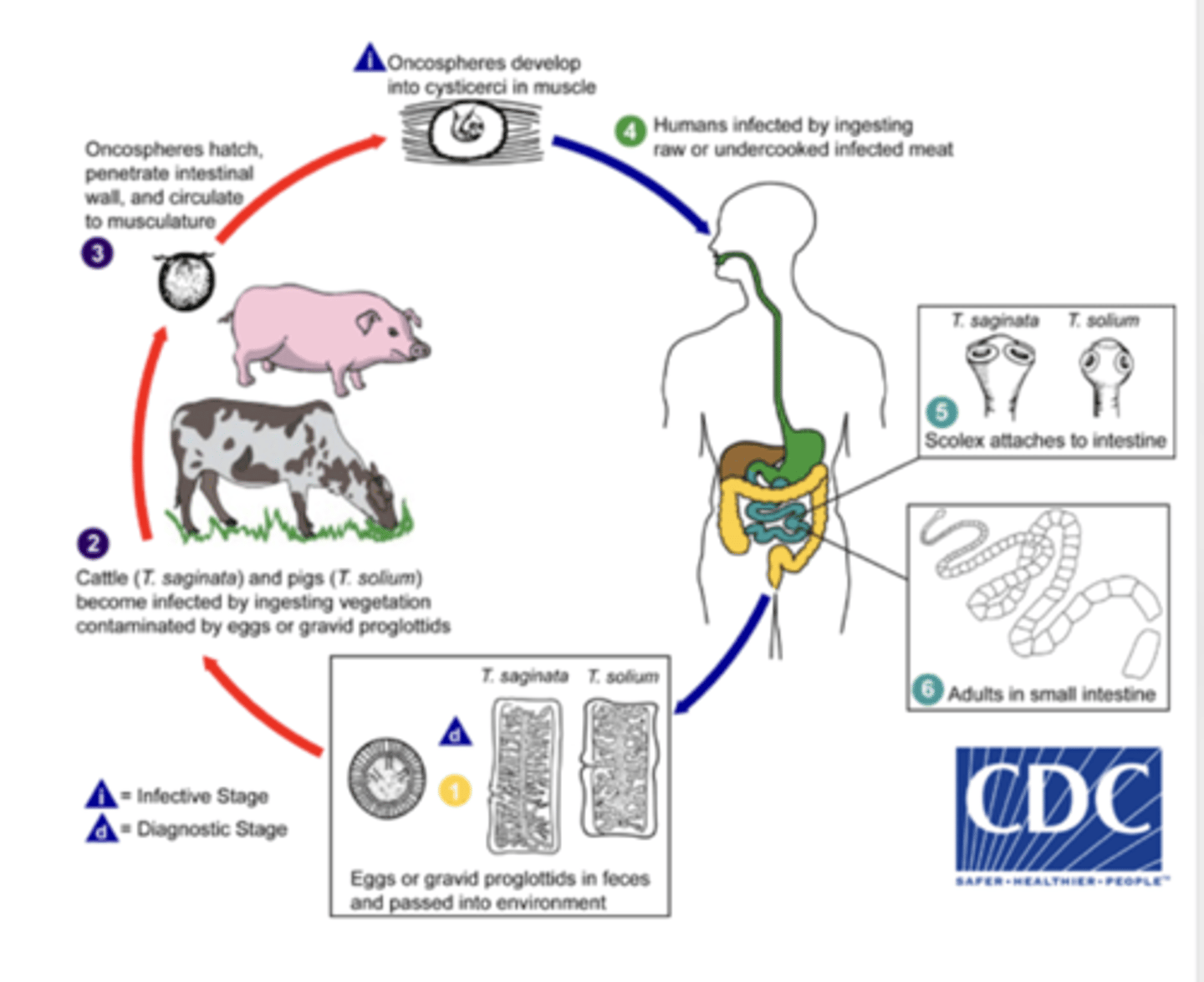
what is the study of fungi
mycology
scientists who study fungi are called
mycologists
where are fungi found
virtually everywhere: >600,000 different species
are fungi harmful or beneficial
some fungi are harmful, some are beneficial
what do fungi include
yeasts, molds, and fleshy fungi (mushrooms)
are fungi plants
NO, fungi are not plants; they are not photosynthetic
what are characteristics of fungi
- Cell walls contain a polysaccharide called chitin.
- Cell membranes contain ergosterols (antifungal drugs)
- Some fungi are unicellular (yeast), while others grow as Multicellular filaments called hyphae.
what are fungal spores
- Help classify fungi
- Spores are either asexual or
sexual
- Not like bacterial spores
- Can be harmful to breath in (Blastomycosis: Blastomyces
dermatitidis)
what are yeasts
type of fungi
where are yeasts found
- in soil and water
- on the skins of many fruits and vegetables
- on humans
what are yeasts used to make
Yeasts have been used for centuries to make wine and beer (Saccharomyces cerevisiae is a yeast used in baking)
what is Candida albicans
yeast most frequently isolated from human clinical specimens: can be a apart of micro biofilm and is only okay in small amounts
what is a fungal disease infection called
mycosis
what is it called when fungal pathogens cycle between hyphae and yeasr-like?
dimorphic
fungal disease characteristics
- chronic: long lasting
- fungi grow slow
- hard to treat
how are people at risk of fungal infections
- Strong antibiotics for a long period of time.
- Immunocompromised
what does it mean for a fungi to be a true pathogen
infect typically healthy hosts
(ex: respiratory infections, such as Histoplasmosis)
what are dermatophytes?
- True pathogens
- Infect skin, hair and nails
- Dermatophytic infections are "(Tinea or ring worm)"
RING WORM: caused NOT by a worm but fungus
- Some fungi can stimulate allergies or produce mycotoxins
what is the comparison of membrane structure in bacteria and eukarya
BOTH: have phospholipid bilayer
what is the comparison of lipid structure in bacteria and eukarya
BOTH: ester linkage and straight fatty acid chains
what is the comparison of sterols in bacteria and eukarya
bacteria have NO sterols
eukarya have sterols
what is the comparison of proteins in bacteria and eukarya
bacteria: HIGH abundance
eukarya: LOW abundance
what are the basic structural components of bacteria
- gram-positive: thick peptidoglycan layer (surface of peptidoglycan layer decorated by teichoic acid)
- gram-negative: thin peptidoglycan layer (outer membrane has phospholipid inner leaflet and lipopolysaccharide outer leaflet)
structure of flagella in bacteria vs. Eukarya
bacteria: non-flexible hollow helical filament and extends outside of cell membrane and cell wall
Eukarya: flexible and covered by cell membrane
assembly of flagella in bacteria vs. Eukarya
bacteria: Flagellin monomers are transported out inside of hollow flagella
Eukarya: Microtubule segments are transported out along the outside of the axoneme via an intraflagellar transport system
arrangement of flagella in bacteria vs. Eukarya
bacteria: Polar (one or multiple) and Peritrichous (multiple)
Eukarya: varies by cell type
motion of flagella in bacteria vs. Eukarya
bacteria: Motor in membrane turns flagella in a screw‐like motion and energy from a proton motive force
Eukarya: Slide microtubules gives a whip‐like motion to the flagella and energy from hydrolysis of ATP
what are bacteriostatic antimicrobial drugs
STATIC: slowed down or preventing further growth
- Prevent bacteria from growing
- tend to target bacterial protein synthesis and metabolic pathways
what are bactericidal antimicrobial drugs
- Kill bacteria
- Tend to target bacterial cell walls or cell membranes and nucleic acids
Bactericidal drugs might seem more
effective, but there are drawbacks like...
- Kills normal microbiota
- Can lead to a spike in bacterial toxin release that can be deadly (e.g., LPS)
what are antibacterial agents
used to treat bacterial diseases
what are antibiotics
a substance produced by a microorganism that kills or inhibits the growth of other microorganisms
what are semisynthetic antibiotics
Antibiotics that have been chemically modified to kill a wider variety of pathogens or reduce side effects are called (ex: ampicillin)
what is the narrow spectrum activity
a small or narrow range of different microbial types they affect (Example: Penicillin- works on Gram positive bacteria)
- if you know what infection you have, you have time to specifically pick out a antibacterial drug
what is the broad spectrum activity
affect a wider range of both Gram-negative and Gram-positive bacteria. ( save time, more destructive)
- not sure of infection or not enough time to find out
is penicillin bactericidal or bacteriostatic, what are some disadvantages?
(bactericidal) Natural
- Penicillin G (injected) and Penicillin V (Oral)
- Narrow spectrum of activity
- Very Susceptible to beta-lactamases: (on a plasmid)
what is a semisynthetic beta lactam
- Contain chemically added side chain
- Broad spectrum
- Side chains
- More stable in acidic environments
- More readily absorbed
- Less susceptible to deactivation
what do beta-lactams target
transpeptidases
what does a beta-lactam ring look like
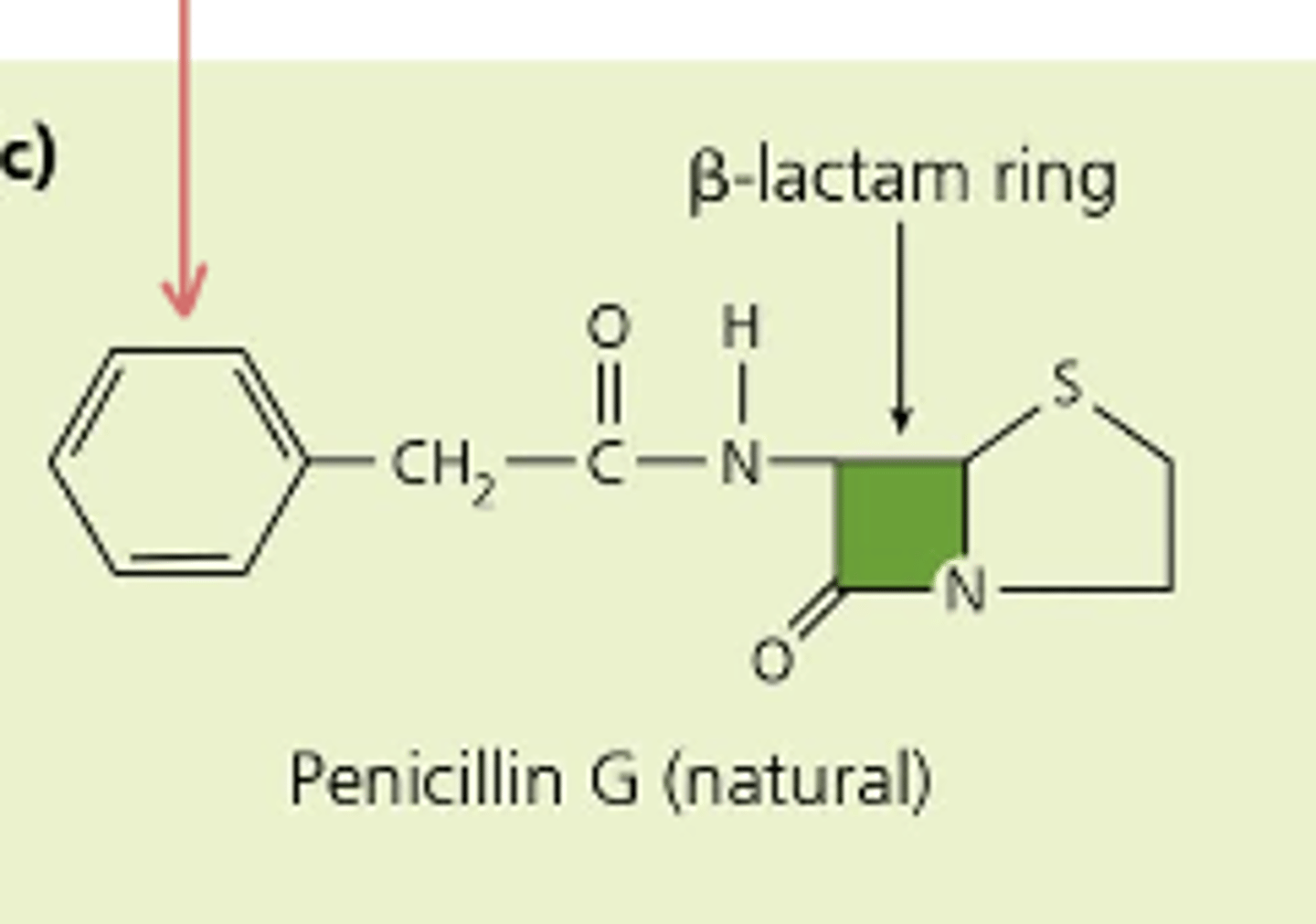
what are non-beta-lactam antimicrobials that target bacterial peptidoglycan synthesis
- Glycopeptides: vancomycin
- Effective against Gram-positive organisms
- Preferred treatment for Clostridium difficile
what are the three ways bacteria can develop resistance
1. target alterations
2. drug inactivation
3. reducing drug concentrations
what are target alterations
altering the drug's target
what is drug inactivation?
Bacteria may produce enzymes that inactivate the drug
what is reducing drug concentrations
Limiting drug entry or pumping drugs out of cells
- naturally resistant: cell wall